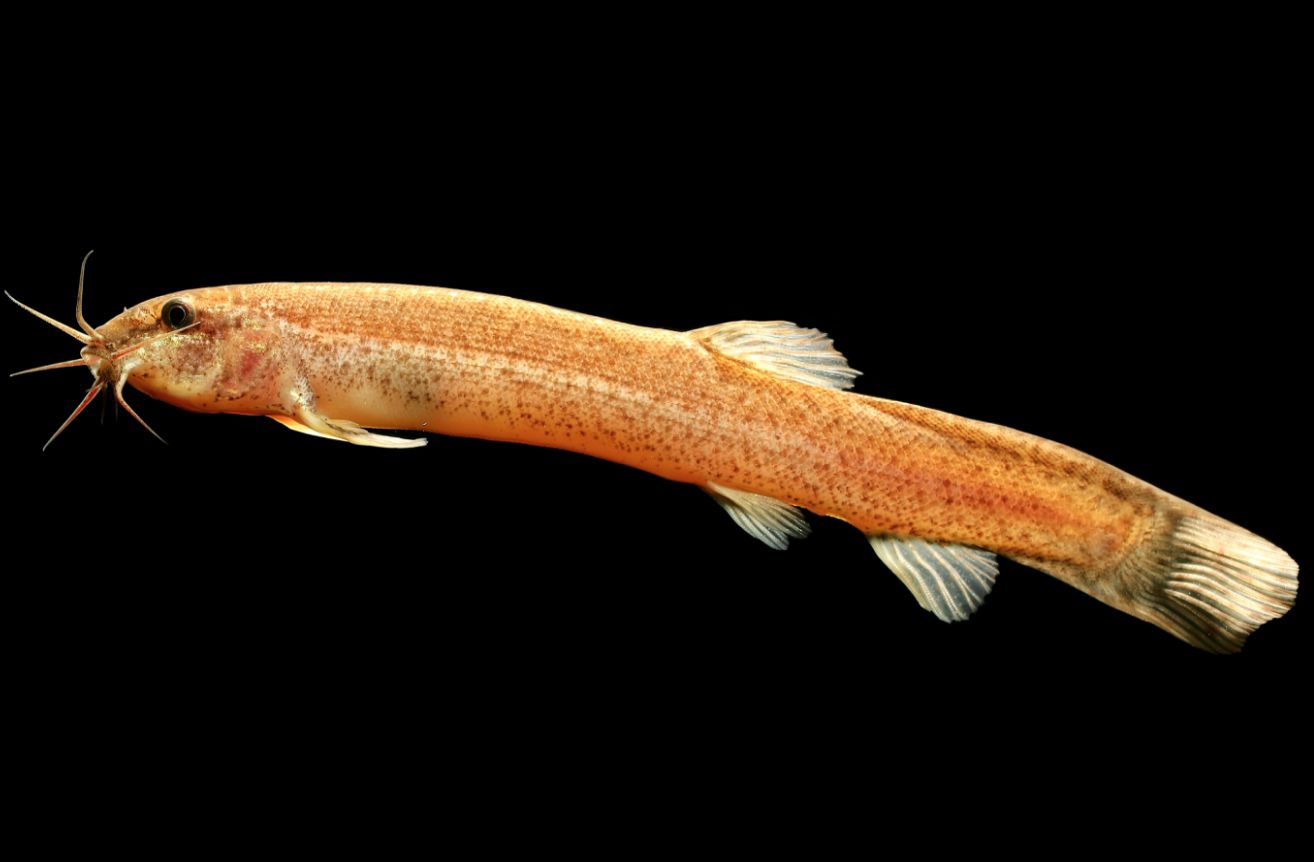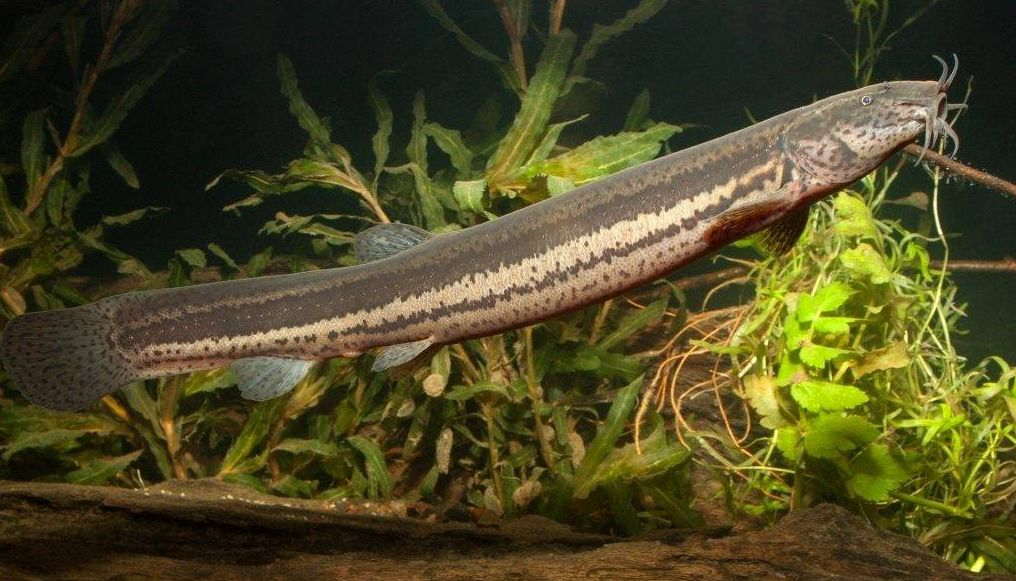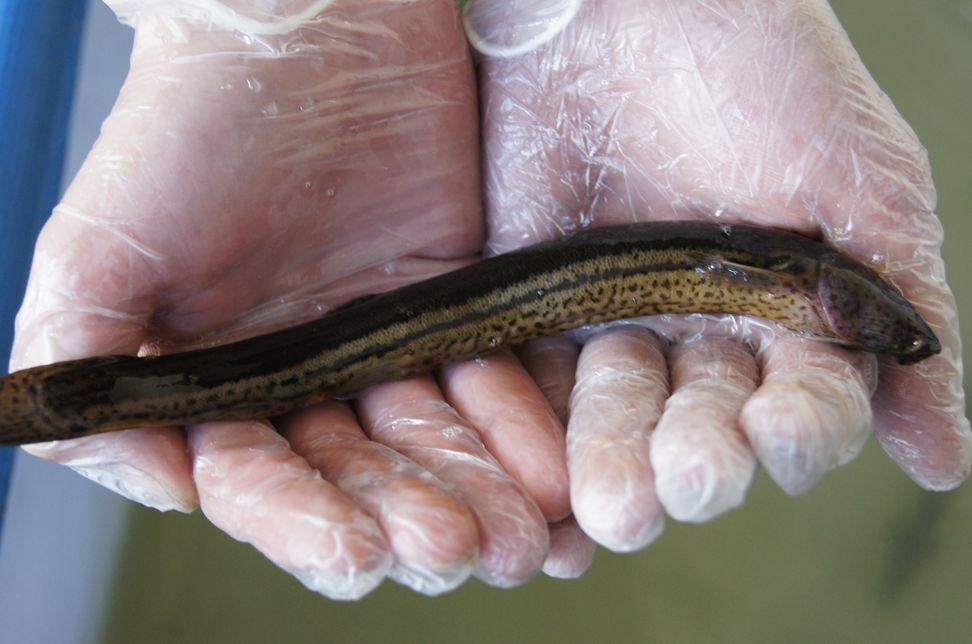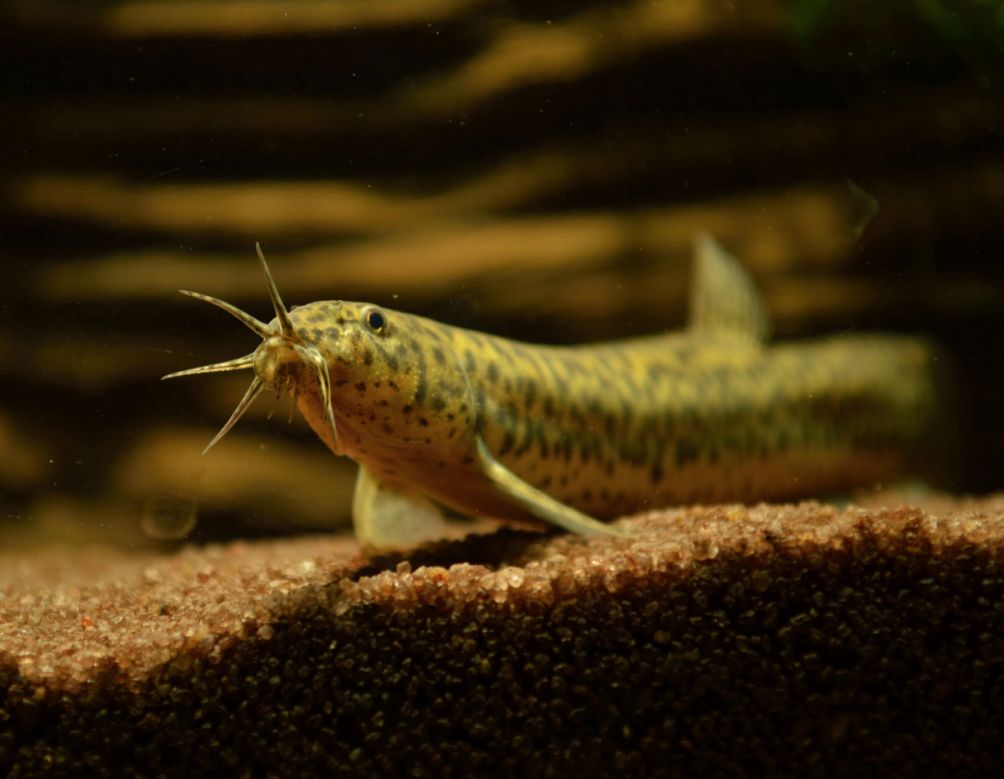The Dojo Loach, also known as the Weather Loach or Pond Loach, is a freshwater fish species native to East Asia. Dojo loach (Misgurnus anguillicaudatus) is a freshwater fish of family Cobitidae, that has been successfully kept in aquaria for many years. Aquarists like the fish for its extraordinary unpretentiousness, peaceful temper and interesting behavior.

Contents
Habitat in the wild
The Dojo Loach (Misgurnus anguillicaudatus) belongs to the Cobitidae family, commonly known as the loach family. The Cobitidae family is a diverse group of freshwater fish species distributed primarily in Eurasia, with some species found in North Africa. Loaches are characterized by their elongated bodies, small scales, and barbels around their mouths.
The dojo loach is endemic to such areas as Siberia, Sakhalin island, Korea, Japan, China, North Vietnam and possibly Laos (as for the latter we don’t know for sure if the fish used to live there initially or it was brought there). However, representatives of this kind successfully assimilated to Germany, Spain, Italy, Kazakhstan, Uzbekistan, Turkmenistan, Philippines, USA (including Hawaiian Islands), Canada and Australia.
Such a wide distribution first of all is due to broad commercialisation of the fish in aquarium husbandry, however the fish is also used as food or as a live squid to catch larger fishes. Its high endurance and adaptability to various conditions, omnivory, high breeding potential and low vulnerability to predators – these are the factors that allowed the weather loach to spread so widely.
Such expansion of area of the fish distribution is a matter of concern since the fish pushes out local fish species from their waters. Because of this it is prohibited to import the fish into some countries. For example, in England you’ll need a special permission to sale and keep this fish species.
More often you can encounter dojo loach in shallow waters of streams and rivers or in bogs, ponds and other lentic or slowly flawing waters. The dojo loach prefers thickly planted areas with fallen leaves on the bottom and sandy/muddy bottom substrate. In rivers it prefers muddy places with lots of plants, quite often these are distributaries, bays and dead stream branches.
If there is very little dissolved oxygen in water the weather loach often swims very close to the water surface, exhales and gasps a new portion of air by making a specific squeak.
Waters purity and depth have seasonal pattern and with some periodicity this fish species can swim into the temporary flooded areas. During drought season some water dwellers can survive in completely dry ponds and when the water comes back these dwellers get back to life.
This weather loach has a rare ability to dig itself into mud 1-2 meters deep and hibernate till the time when water gets back to the place again. In general, this loach can live in any kind of lentic waters, even in bogs. The unique ability of the dojo loach to live without water for a long time is explained by the fact that unlike most of the fishes it can breathe not only using its gills, but also by with its skin and intestinal tract.
Its gut walls have a lot of blood vessels and they perform respiratory function in case when the fish organism feels the lack of oxygen. When gasping air the dojo loach takes it through the intestinal tract and then exhales through the spout-hole (this process explains the squeak sound loaches make when you take them out of water).
Some fishermen say that large species as well as eels can crawl from one pond to another (closely located) in the early morning when it is dewy. There are some records about species who survived quite long stay in wet sand or mud without any water.
Why weather loach?
Well, this is due to its interesting feature – sensitivity to atmospheric pressure and weather changes. Before this happens the loach starts demonstrating disquiet behavior, it swims all around the tank and looks out from the water. Conversely, when the atmospheric pressure rises, they tend to become more sedentary and may bury themselves in the substrate or hide in other areas of the aquarium.
This behavior is attributed to the dojo loach’s ability to detect changes in barometric pressure and respond to it. It is believed that changes in the air pressure can affect the swim bladder of the loach, causing them to exhibit these unusual swimming behaviors. Hence, the name “Weather Loach” emerged from the association between their behavior and changes in the weather.
People in many countries have noticed this peculiarity (in Japan, for example), they kept the dojo fish as a barometer that predicts weather change. Using the dojo fish behavior scientists very often find out not only about weather changes, but also about nature disasters that are coming, such as tsunami or earthquakes.


Description
Loaches have elongated body covered with small but clearly seen scales. The mouth is edged with 10-12 barbels; the tail fin is rounded. Its infraorbital spine is hidden deep under the skin and it doesn’t function.
The dojo loach has small yellow or brown eyes. The color intensity depends on its living environment. The body is light olive, greenish colored with lots of small spots on it, but you can also encounter white and golden species.
Golden dojo loach
There is a golden variety of the fish which is usually sold as “golden dojo loach”. It is partially an albino form, the body is pinkish with yellow tint, the eyes are dark colored. The golden dojo joach’s unique golden coloration adds an appealing visual element to an aquarium. It can stand out against different types of substrates and aquarium decor, creating a beautiful and eye-catching display.
How big do dojo loaches get?
The dojo loach can reach an average size of 6 to 12 inches (15 to 30 cm) in length. However, some individuals have been known to grow larger, occasionally reaching sizes of up to 12 to 15 inches (30 to 38 cm) or even more in rare cases.. Pay attention, that this is the size that makes it different from another tank fish – kuhli loach. Both fishes have similar structure (but kuhli has very specific coloring) and at that the fishes have very different size.
How long do loaches live?
The dojo loach lifespan depends on the water temperature where it dwells. It prefers cool water with the temperature lower, than that for tropical fishes. Provided with such water temperature the loach can live for 10 to 15 years or even longer in captivity. Some well-cared-for individuals have been known to live beyond 15 years. If the water is warmer the lifespan gets shorter and it is about 8 years.
| Characteristic | Description |
|---|---|
| Scientific Name | Misgurnus anguillicaudatus |
| Common Names | Dojo Loach, Weather Loach, Pond Loach, dojo eel |
| Family | Cobitidae |
| Native Range | East Asia (China, Japan, Korea, Taiwan) |
| Size | 6 to 12 inches (15 to 30 cm) in captivity |
| Lifespan | 10 to 15 years or longer in captivity |
| Body Shape | Elongated, eel-like |
| Coloration | Yellowish-brown or olive with darker patches, lighter underside |
| Fin Type | Fins are transparent and delicate |
| Temperament | Peaceful |
| Behavior | Nocturnal, bottom-dweller, burrows in substrate |
| Feeding Habits | Omnivorous, eats small invertebrates, insects, worms, and plants |
| Aquarium Size | Minimum 30 gallons (113 liters) |
| Water Temperature | 64°F to 75°F (18°C to 24°C) |
| pH Range | Neutral to slightly alkaline (around 7.0 to 8.0) |
| Water Hardness | Tolerant of a wide range, slightly soft to moderately hard |
| Tank Setup | Soft substrate (sand or fine gravel), hiding spots, plants |
| Compatibility | Peaceful community fish, avoid aggressive or fin-nipping species |
| Breeding Difficulty | Challenging, requires specific conditions and setup |
| Special Feature | Can breathe atmospheric oxygen with a labyrinth organ |
Difficulties in keeping
This is one of the most undemanding tank fishes, which is perfect for beginners and those who can’t spend much time on taking care of a tank and its dwellers. But, keep in mind that to keep weather loach successfully you’ll need quite cool water in the tank.

Care and keeping in a tank
Tank decor
This fish isn’t difficult in terms of keeping, but you have to provide it with soft and small grained bottom substrate. Large stones with sharp edges can damage delicate skin of the loach and the fish will be stressed if it doesn’t have a chance to dig itself into the bottom substrate.
Perfect bottom substrate is small grained sand. Large smooth snags and stones as well as other various tank decorations will do for the dojo loach, since the more shelters are in the tank the better.
Tank lighting should be moderate, it is desirable to shadow the tank bottom by putting floating plants into the tank. If you want, you can add some fallen leaves to create conditions that are close to the fish habitat.
Make sure that there are safety caps on the filters and the tank is covered with a lid, since most of species tend to jump out of the tank, especially at the beginning. But even if you have found the loach on the floor, put it back into the tank, because there is a chance it will be fine quite quickly.
Despite its high adaptability to various conditions, it is not recommended to put this fish species directly into a new tank without a settled biotope.
Water parameters
Proper tank water parameters are the following:
- Dojo loaches can tolerate a wide range of pH levels, but they generally prefer slightly alkaline to neutral water conditions. A pH range of 7.0 to 8.0 is suitable for Dojo Loaches. It’s important to avoid extreme fluctuations in pH, as it can cause stress and impact their well-being.
- Dojo Loaches are relatively adaptable to different water hardness levels. They can thrive in a wide range of water hardness, from slightly soft to moderately hard. Aim for a general hardness (GH) level of 8 to 12 degrees and a carbonate hardness (KH) level of 6 to 12 degrees.
- As for the temperature, in general this species will stand the range 5—25 °C, however the recommended tank water temperature is (68-72 °F, 20-23 °C). The pond loach can live at higher temperature, but it shortens its lifespan as well as the fish is more prone to various infections at such conditions. It is important to keep in mind that this isn’t a tropical fish and it shouldn’t be kept at tank conditions which are extreme and unusual to it.
- Dojo loaches are sensitive to poor water quality, particularly high levels of ammonia and nitrites. Regularly test and maintain low levels of ammonia (0 ppm), nitrites (0 ppm), and nitrates (ideally below 20 ppm) to ensure optimal water conditions for your dojo joaches. Performing regular water changes and using a reliable filtration system are important for keeping these parameters in check.
Diet
Weather loach is omnivorous; insects larvae, small crustaceans and others are the basis of the diet. In a tank you can feed the fish with artificial food that sinks out on a tank bottom. High-quality commercial fish foods, such as sinking pellets or granules, can serve as the foundation of their diet. Look for specifically formulated foods for bottom-dwelling fish or omnivorous species. Ensure the pellets or granules are small enough for the dojo loaches to consume easily.
However, the diet should include frozen or live food (daphnia, bloodworm, worms). Dojo loach gets very attached to its owner and they like when he strokes them or feeds them from his hands.
Tank mates
The dojo loach is undemanding in terms of keeping in a tank; it is active and peaceful, but it may prey on juveniles or eat fish eggs. You can keep just one fish in a tank, but they feel more comfortable in a company of its kind.
Perfect tank mates are goldfish. They require the same tank water temperature, they aren’t rivals in terms of food and they swim in different water layers. Loaches eagerly eat food leftovers that goldfish leave, which decreases the level of ammonia and nitrates content in the tank.
You can select any fishes that dwell in upper and medium water layers as tank mates; at that, they shouldn’t be large and aggressive. If these fishes aren’t aggressive towards dojo loach, they will be able to share the tank successfully (for example betta, angelfish). It’s worth mentioning that freshwater shrimps (like cherry shrimp) may be the fish prey.
Gender differences: male vs female
Determining the sex of dojo loaches (Misgurnus anguillicaudatus) can be challenging as they do not display distinct physical characteristics that differentiate males from females.
However, there are a few subtle differences that can sometimes help identify the sex of mature dojo loaches:
- Body Shape: Mature female tend to have a rounder and plumper body shape compared to males. This difference is more noticeable during the breeding season when females may appear slightly fuller due to the development of eggs.
- Fin Rays: In some cases, the anal fin of mature males may have slightly thicker or more prominent fin rays compared to females. However, this difference can be challenging to observe and may not be reliable for sexing dojo loaches.
- Behavior: During the breeding season, males may exhibit more active and aggressive behavior as they compete for female attention. This behavior can include chasing or nipping at other males. However, this behavioral difference may not be apparent outside of the breeding period.
Given the difficulty in reliably sexing dojo loaches based on physical characteristics, it is often best to observe their behavior during breeding periods or consider purchasing a group of individuals to increase the likelihood of having both males and females. Breeding behavior and the presence of eggs or fry can confirm the sex of individual dojo loaches in a tank.
If breeding is not a priority, Dojo Loaches can be enjoyed in a community aquarium regardless of their sex, as they are peaceful and interesting bottom-dwelling fish.
Breeding
Information about breeding in captivity is quite fragmented and limited. Presumably in farm hatcheries they use hormone injections for this purpose, because this species are highly demanded on the market (aquarists, food industry and scientists – they all need it).
In the wild spawning occurs as follows: the pond loach male during its mating display hugs the female and fertilizes the eggs she lays. Then the eggs sink out on the substrate. The female dojo loach fish lays about 100-150 eggs among algae. The eggs are 1,7-1,9 mm in diameter, not very sticky, they have light brownish color.
At water temperature 14-16 °C the egg stage lasts for about 4 days. Once the larvae hatches, they have additional respiratory organs represented by external gills.
Except this, dense network of blood vessels in large pectoral fins and later those in intestinal tract of the larvae also perform additional respiratory function.
Being about 8 mm long on the 12th day of their life the larvae starts to feed. They look for food by means of special sensory organs located around their mouth and on the barbels (they develop very early).
At the age of 26 days old their external gills get completely reduced. Juvenile stage starts when the larvae becomes 30 mm long.